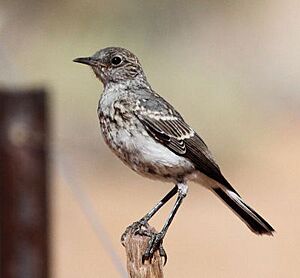Karoo chat facts for kids
Quick facts for kids Karoo chat |
|
|---|---|
 |
|
| In Northern Cape, South Africa | |
| Conservation status | |
| Scientific classification | |
| Genus: |
Emarginata
|
| Species: |
schlegelii
|
| Synonyms | |
|
Cercomela schlegelii |
|
The Karoo chat (Emarginata schlegelii) is a small bird found in parts of Africa. It belongs to the Old World flycatcher family. You can often see this bird in southwestern Angola, western Namibia, and western South Africa. It likes to live in Karoo and desert areas.
Contents
About the Karoo Chat's Name
The Karoo chat got its first official description in 1855. A Swedish scientist named Johan August Wahlberg gave it the name Erithacus schlegelii. Later, it was placed in a group called Cercomela.
Scientists then studied the birds' DNA. They found that Cercomela was not a good fit for this bird. So, the Karoo chat was moved to its current group, Emarginata. The name schlegelii honors a German bird expert, Hermann Schlegel.
Different Kinds of Karoo Chats
There are four types, or subspecies, of the Karoo chat:
- E. s. benguellensis (Sclater, WL, 1928) – found in southwestern Angola and northwestern Namibia
- E. s. schlegelii (Wahlberg, 1855) – found along the coast of Namibia
- E. s. namaquensis (Sclater, WL, 1928) – found in southern Namibia and northwestern South Africa
- E. s. pollux (Hartlaub, 1866) – found in western and central South Africa
What Does a Karoo Chat Look Like?
The Karoo chat is about 16 to 18 centimeters long. That's about the length of a pen. It weighs around 32 grams, which is like a few coins.
Its back and top parts are grey. It has a reddish-brown patch right behind its eye. Its tail is black with white feathers on the outside edges. The bird's belly and chest are white. Its short, straight beak, legs, and feet are black. Its eyes are dark.
Boy and girl Karoo chats look very similar. Young Karoo chats look a bit different. They have spots and their underparts look scaly.
You might confuse it with a female mountain wheatear. But the Karoo chat has a grey rump, not a white one. Its outer tail feathers are completely white. These features also help tell it apart from the tractrac or sickle-winged chats.
The Karoo chat makes calls that sound like chak-chak and trrat-trrat.
Karoo Chat Habits
Reproduction and Nests
The Karoo chat builds a nest shaped like a cup. It uses straw and leaves to make it. The nest is usually on the ground, hidden under a bush or shrub. The female lays two to four green eggs. These birds usually stay with the same partner for their whole lives.
What Do Karoo Chats Eat?
You will usually see Karoo chats alone or in pairs. They look for food on the ground. They eat many kinds of insects. This includes butterflies, bees, wasps, locusts, and ants. They often catch their prey by flying a short distance.
Is the Karoo Chat in Danger?
The Karoo chat is a common bird. It lives across a very large area. This area is estimated to be about 1,100,000 square kilometers. Scientists believe there are many Karoo chats.
The number of Karoo chats is not dropping quickly. It is not declining by more than 30% over ten years. Because of this, scientists say the species is of "Least Concern." This means it is not currently in danger of disappearing.



